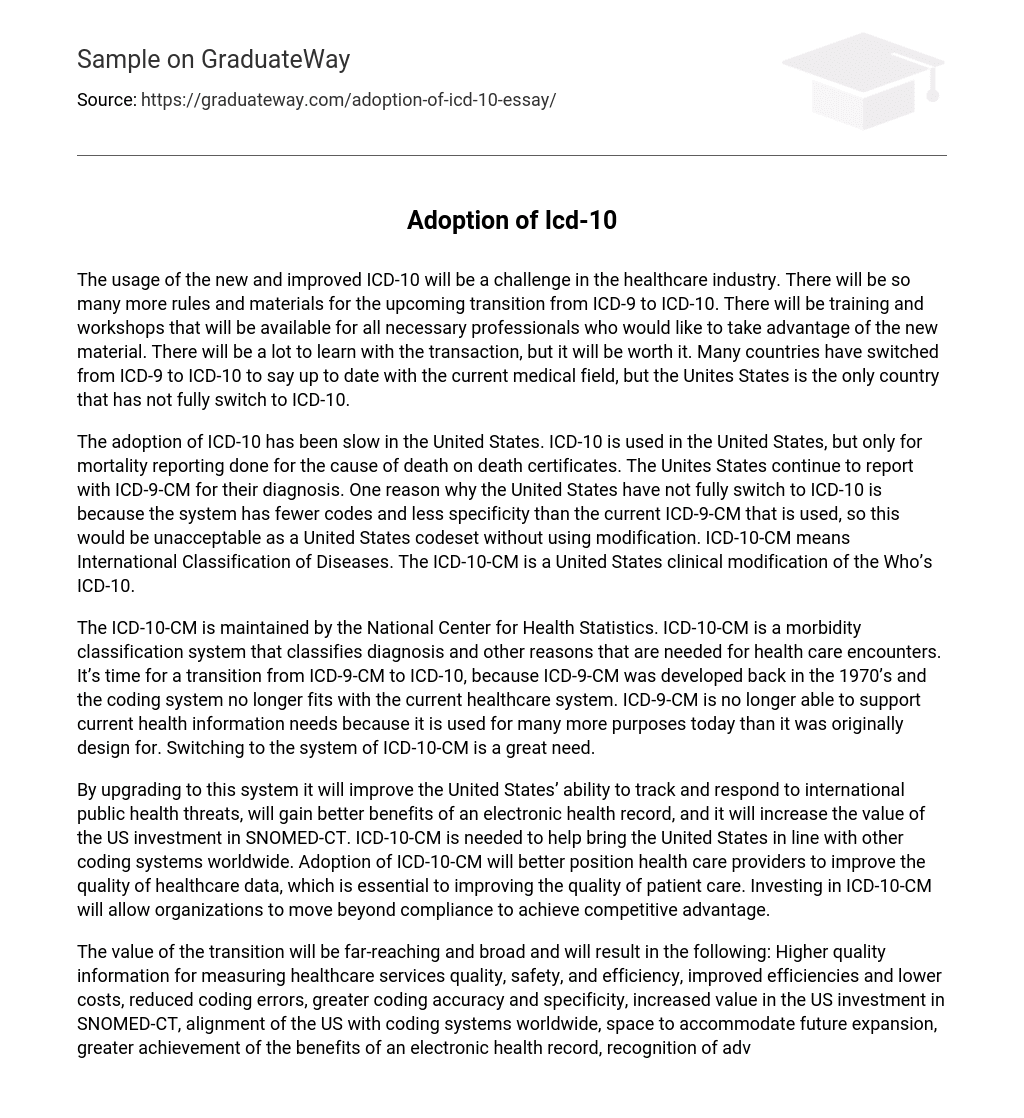The healthcare sector in the United States will face a challenge when implementing the new and improved ICD-10. The transition from ICD-9 to ICD-10 will necessitate additional regulations and resources, but training programs and workshops will be offered to all relevant professionals to ensure they can benefit from the updated material. Although there is an abundance of information during this transition, it will ultimately prove valuable. It’s important to note that unlike other countries in the medical field, only the United States has not fully adopted ICD-10.
The implementation of ICD-10 in the United States has been slow, with its current usage limited to reporting mortality on death certificates. Meanwhile, ICD-9-CM continues to be used for diagnosis. The reason behind this is that ICD-10 has a reduced number of codes and is less precise compared to ICD-9-CM. Due to its lack of specificity, it is not considered acceptable in the United States without modification.
In order to tackle this issue, a modified version known as ICD-10-CM (International Classification of Diseases) was specifically developed for use in the United States.
The National Center for Health Statistics is in charge of the ICD-10-CM, a system for classifying illness diagnoses and healthcare encounters. Switching from ICD-9-CM to ICD-10-CM is essential because the latter is better suited for today’s healthcare system compared to its outdated counterpart from the 1970s. Since ICD-9-CM has been used beyond its original purpose, it no longer meets current health information requirements. Therefore, there is an urgent need to implement the ICD-10-CM system.
Upgrading to this system will enhance the United States’ capability to track and respond to international public health threats, gain better benefits of an electronic health record, and increase the value of the US investment in SNOMED-CT. The implementation of ICD-10-CM is necessary to align the United States with other global coding systems. Adopting ICD-10-CM will position healthcare providers to enhance the quality of healthcare data, which is crucial for improving patient care. Investing in ICD-10-CM will enable organizations to go beyond mere compliance and attain a competitive advantage.
The transition will have a wide-ranging impact and lead to various benefits, including improved measurement of healthcare service quality, safety, and efficiency, cost reduction, lowered coding errors, increased coding accuracy and specificity, enhanced value in US investment in SNOMED-CT, alignment with global coding systems, room for future growth, better utilization of electronic health records, acknowledgment of advancements in medicine and technology, and improved ability to monitor and address international public health risks.
These are just a couple of advantages that will benefit the United States in the transition of ICD-10-CM. The need for ICD-10-CM is justified by these many advantages. ICD-10-CM is the preferred option. Although the transition may require time and patience, it is valuable in improving the United States. The layout and major conventions utilized in ICD-10-PCS are not complex. Developed by CMS, ICD-10-PCS is designed for inpatient procedure codes and replaces volume 3 ICD-9 procedure codes. ICD-10-PCS is exclusively intended for use within the United States.
The system was created by 3M Health Information Management for the Centers for Medicare and Medicaid. ICD-10-PCS development encompassed four main attributes: completeness, expandability, standardized terminology, and multi-axial. Completeness mandates a distinct code for every significantly different procedure. In terms of expandability, ICD-10-PCS structure should facilitate the effortless integration of newly developed procedures as unique codes. Standardized terminology implies that ICD-10-PCS should provide definitions for the utilized terminology.
The purpose of ICD-10-PCS is to provide precise definitions for terms and avoid using eponyms or common procedure terms. The codes in multi-axial ICD-10-PCS are composed of separate characters, and each component retains its meaning across different codes whenever feasible. The alphanumeric structure of ICD-10-PCS comprises seven characters, with a maximum of 34 potential values for each character. The sections in ICD-10-PCS are identified by the numbers 0-9 and letters A-H, J-N, and P-Z.
The table below displays the conversion from ICD-9-CM to ICD-10-PCS. Each code is generated by selecting a specific value for each of the seven characters in ICD-10-PCS, which determine various aspects of the procedure performed such as section, body system, root operation, body part, approach, device, and qualifiers.
ICD-9-CM ICD-10-PCS
789.00 Abdominal Pain unspcf site R10.9 Abdom. Pain
787.02 Nausea alone R11.0 Nausea, vomiting
780.4 Dizziness and giddiness R42 Dizziness
787.91 Diarrhea R19.7 Diarrhea
780.60 Fever NOS 784.0 Headache
R50.9 Fever
R51 Headache 555.9 Regional enteritis NOSK50.90 Crohn’s 786.2 CoughR05 Cough 493.90 Asthma NOSJ45.909 Asthma 786.50 Chest Pain NOSR07.9 Chest Pain
References:
- Retrieved June 22, 2010, website: http://www.aapc.com/ICD-10/codes/index.aspx
- Retrieved June 22, 2010, website: http://www.aapc.com/ICD-10/naming-conventions.aspx
- Retrieved June 22, 2010, website: http://www.ahima.org/icd10/understanding.aspx
- Retrieved June 22, 2010, website: http://www.ahima.org/icd10/value.aspx
- Retrieved June
22 ,20 l O , w ebsite : h ttp : / /w w w . a h i m a . o r g / i c d I O /
replaced.as p x





